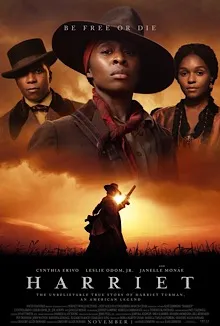Historical accuracy of Harriet

Historical accuracy of Harriet

Characters
Harriet Tubman (Araminta "Minty" Ross)
Based on the real Harriet Tubman. The film accurately portrays her escape from slavery, her work on the Underground Railroad guided by faith and visions, her bravery, and her role in the Civil War.
Gideon Brodess
A fictional character created for the film. While Harriet's enslaver Edward Brodess and his family were real, Gideon and his personal, persistent pursuit of Harriet throughout the narrative are dramatic inventions.
Eliza Brodess
Based on the real Eliza Ann Brodess. She did become Harriet's legal enslaver after her husband Edward's death, and her desire to profit from enslaved people, including selling them, is historically accurate.
William Still
Based on the real William Still, a key figure in the Underground Railroad in Philadelphia who documented the stories of those he helped. His meeting with Harriet and support are accurately depicted.
Marie Buchanon
A fictional character representing the established free Black community in Philadelphia that helped newly escaped individuals adjust. She serves as a friend and guide to Harriet but is not based on a specific person.
Reverend Samuel Green
Based on the real Reverend Green, a free Black minister on Maryland's Eastern Shore who was an active agent on the Underground Railroad and assisted Tubman.
More characters
John Tubman
Based on Harriet's real first husband. His status as a free man and his decision not to flee with Harriet (leading to their separation) are historically accurate, though nuances may be simplified.
Ben Ross
Based on Harriet's real father.
Rit Ross
Based on Harriet's real mother. Her deep family bonds and fear for her children are accurately represented.
Bigger Long
A fictional character. While the existence of Black individuals who collaborated with the slave system in various complex ways is noted by some historians, organized, independent Black slave catchers like Long are considered largely a myth or exaggeration by most historians, making this character historically problematic.
Walter
A fictional character associated with the problematic Bigger Long subplot.
Harriet's siblings (Robert, Henry, Ben etc.)
Based on Harriet's real siblings and other family members whom she successfully guided to freedom via the Underground Railroad.
Story
Harriet's enslavement on Maryland's Eastern Shore
Accurately depicts Harriet's birth into slavery in Dorchester County, Maryland, and the conditions she endured.
Fear of being sold South after enslaver's death
Edward Brodess's death increased the likelihood of his enslaved people being sold to settle debts, a common occurrence and major fear motivating Harriet's escape.
Experiencing divine visions/guidance ("spells")
Tubman attributed her premonitions and guidance to direct communication with God, likely related to a severe head injury she sustained as a youth. The film accurately portrays her faith and these experiences.
Harriet's solo escape to Philadelphia (approx. 100 miles)
After an initial attempt with her brothers failed, Harriet successfully escaped alone, travelling north through Maryland and Delaware to reach freedom in Pennsylvania, aided by the UGRR network.
Meeting William Still and abolitionists in Philadelphia
Upon arriving in Philadelphia, Tubman connected with William Still and the Pennsylvania Anti-Slavery Society, crucial contacts in the abolitionist movement.
Becoming an Underground Railroad conductor ("Moses")
Tubman famously returned to Maryland multiple times (around 13 documented trips) over ten years, rescuing approximately 70 enslaved people, including family and friends, earning her nickname "Moses."
Using spirituals as coded messages
Tubman and other UGRR operatives reportedly used coded language within songs like "Go Down Moses" and "Wade in the Water" to communicate escape plans and directions.
Dramatic confrontations with Gideon Brodess
The recurring direct confrontations between Harriet and the fictional Gideon are fabricated for cinematic drama. Tubman's success relied on stealth and avoiding enslavers during rescues.
Inclusion of Bigger Long as Black slave catcher antagonist
This character and subplot are fictional and controversial, considered by many historians to perpetuate a largely inaccurate stereotype about Black slave catchers.
Harriet carrying a pistol
Some historical accounts and Tubman's own statements suggest she carried a firearm for protection. Reports of her threatening reluctant escapees are less substantiated and debated among historians.
John Tubman remarrying after Harriet escaped
When Harriet returned for her husband John, she found he had taken another wife and did not want to leave Maryland.
Leading the Combahee River Raid during the Civil War
Tubman served as a spy, scout, and nurse for the Union Army and played a significant role in planning and guiding this successful 1863 military raid in South Carolina, which freed over 700 enslaved people.
Setting
Antebellum Maryland's Eastern Shore
Accurately portrays the geography and the specific nature of slavery in a border state, including the ever-present risk of being sold South and the complex interactions between enslaved and free Black people.
Philadelphia as an abolitionist hub
Realistically depicts Philadelphia as a vital center for the abolitionist movement and the Underground Railroad, showcasing the activities of figures like William Still and the free Black community.
Operation of the Underground Railroad (UGRR)
Illustrates the network of secret routes, safe houses ("stations"), and brave individuals ("conductors," "station masters" - Black and white) who risked their lives to help people escape slavery.
Conditions under chattel slavery
Effectively portrays the brutality, dehumanization, forced labor, family separations, lack of freedom, and constant surveillance and threat of violence inherent in the institution of slavery.
Costumes and period details
Generally accurate representation of clothing, hairstyles, and material culture for enslaved people, free Black communities, and white society in the mid-19th century.
Atmosphere leading up to/during the Civil War
Captures the rising tensions over slavery in the 1850s (e.g., Fugitive Slave Act implications) and accurately integrates Tubman's later work into the context of the Civil War conflict.
Natural landscapes used for escape routes
Shows the woods, swamps, and rivers that served as pathways and hiding places for those escaping slavery, reflecting the real terrain Tubman navigated.
